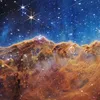ISRO, NASA space telescopes spot furthest stars and oldest galaxies
NASA's James Webb Telescope and ISRO's AstroSat have revealed new discoveries from the furthest reaches of the universe, including galaxies and new star formations.
NASA's James Webb Space Telescope has been in the news recently for the astonishing new pictures it has captured of star formations. Now, the scientists analysing the telescope's data believe that it has captured images of the oldest galaxies in the universe.
According to a report by NASA, the two potential galaxies, named the GLASS-z11 and the GLASS-z13, are suspected to be over 33 billion light years away from Earth. The study detailing this data believes that these galaxies were formed during the first 300 million years of the universe's existence.
To date, the only other galaxy confirmed to have been formed so soon after the big bang is the GNz11, which was discovered in 2015. The paper detailing the discovery of GLASS-z11 and GLASS-z13 is yet to be peer reviewed, and the study is led by Rohan Naidu of the Harvard-Smithsonian Center for Astrophysics.
ISRO's AstroSat discovers new star formations
In a peer-review study published in Nature last week, a team of Indian, American, and French astronomers led by Pune's Inter-University Centre for Astronomy and Astrophysics has used data from ISRO's AstroSat space telescope to identify 13 new star formations at the edge of the universe.
These star formations have been found on the edge of the dwarf galaxies on the outer rim of the universe, and show signs of drifting towards the galaxies in the question, adding to the latter's mass and volume. This discovery is believed to be significant because the growing mass makes it easier for scientists to study these notoriously faint early 'blue compact dwarf' (BCD) galaxies.
Launched by ISRO in 2015, the AstroSat observes distant objects on the other end of the electromagnetic spectrum compared to the James Webb. NASA's telescope primarily studies the universe in infrared wavelength, while AstroSat observes the universe using ultraviolet (UV), X-ray, and visible light.
Edited by Megha Reddy








